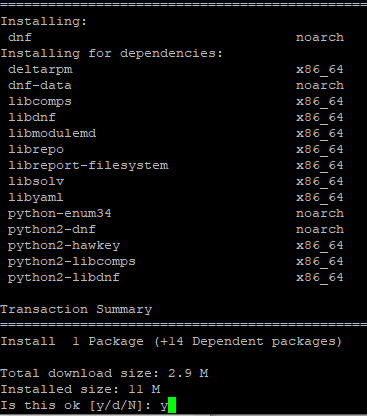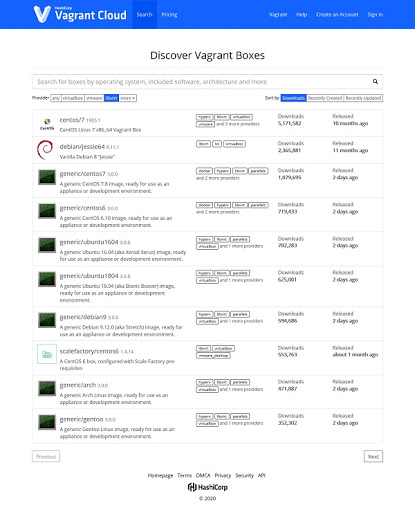

Click on the image for instructions on how to use the virtual machine. You can find images by browsing or searching the main hub for boxes /boxes/search.įor this example, search for "centos" and find the entry named generic/centos8. In contrast, others try to solve a specific need (for instance, you might find a LAMP stack image ready for web development). Some images are minimal, intended to serve as a base for customization. Finding a Vagrant virtual machineīroadly speaking, Vagrant boxes come from three different places: Hashicorp (the maintainers of Vagrant), maintainers of distributions, and people like you and me. Now you need to find a virtual machine so you can convert the directory you've just made into a Vagrant environment. On Linux, your distribution may already have libvirt installed, but to enable integration with Vagrant you need a few other packages, too. vagrant_X.Y.ZZ_x86_64.deb Installing libvirt and support packages
VAGRANT CENTOS INSTALL
On Debian, Linux Mint, Elementary, and similar, you get a DEB package, which you can install with apt: $ sudo apt install. There are builds available for Debian-based systems, CentOS-based systems, macOS, Windows, and more.įor CentOS, Fedora, or similar, you get an RPM package, which you can install with dnf: $ sudo dnf install.

I use libvirt as the backend for Vagrant because it's useful across several applications, including virt-manager and GNOME Boxes. You might think of it as a sort of virtual machine API, allowing developers to write friendly applications that make it easy for users to orchestrate virtualization through libvirt. The libvirt project is a toolkit designed to manage virtualization, with support for KVM, QEMU, LXC, and more. It can use VirtualBox or, through a plug-in, the lightweight libvirt project as a backend. It only manages your virtual machines ("boxes" in Vagrant terminology). It's not a virtualization framework itself. Vagrant itself is relatively minimal, too. It's ideal for web developers needing a test web server, programmers who need to test an application across distributions, and hobbyists who enjoy seeing how different distributions work. It's the quickest you'll ever set up a virtual machine. It allows you to easily pull a minimal and pre-built virtual machine from the Internet, run it locally, and SSH into it in just a few steps. Vagrant is a simple virtual machine manager for your terminal.
VAGRANT CENTOS FREE
Free online course: RHEL Technical Overview.The host will expose the WebServer on port 5150, so point your browser at You can mount directories from your local file system into the Vagrant host by modifying the Vagrantfile. When the process is done you can SSH to your Vagrant host with vagrant ssh. Once these files are created, issue a vagrant up command to pull down the Chef image and start the provisioning process.
VAGRANT CENTOS UPDATE
InstallGcc # = # Update VirtualBox Additions # =įi # = # Install software # =ĬonfigureShell # = # Configure Environment # = if thenĬat > /etc/httpd/conf/nf Alias /webapp /local/www/webapp Options Indexes FollowSymLinks MultiViews AllowOverride All Order allow,deny Allow from all EOM # We need it to rebuild the VirtualBox Guest Additions # = # We need them to rebuild the VirtualBox Guest Additions # = # = # Main Section # = # = # Set Timezone # = Perl -pi -e "s/ date.timezone.*/date.timezone = \"America\/Chicago \"/g " /etc/php.ini Yum -y -nogpgcheck -quiet install /opt/packages/oracle-instantclient11.2-devel-11.2.0.4.0-1.x86_64.rpmĬat > /etc/profile.d/oracle.sh > /etc/php.ini # = # Install Oracle Support for PHP # () # = if then Value= $(grep -c "set tabstop=2 " ~vagrant/.vimrc ) if then echo 'set tabstop=2 ' > ~vagrant/.vimrc Value= $(grep -c "set -o vi " ~vagrant/.bashrc ) if then echo 'set -o vi ' > ~vagrant/.bashrc Value= $(grep -c "set tabstop=2 " ~root/.vimrc ) if then echo 'set tabstop=2 ' > ~root/.vimrcįi # = # Setting up annoying shell and vim configs for vagrant. Value= $(grep -c "set -o vi " ~root/.bashrc ) if then echo 'set -o vi ' > ~root/.bashrc # = # Set up annoying shell and vim configs for root. Value= $(rpm -qa vim-enhanced | wc -l ) if then PrintLog "Installing Fedora RPM Signing Key " PrintLog "Installing CentOS RPM Signing Key " Value= $(rpm -qi gpg-pubkey | grep -c ' ) if then Value= $(rpm -qa | grep -c ^kernel-devel ) if then Value= $(rpm -qa | grep -c ^gcc ) if then Perl -pi -e 's/#ServerName localhost.localdomain:80/g ' $FILE # = # Functions # = start_if_stopped () -bootstrap] $1\n " TIME_ZONE_FILE=/usr/share/zoneinfo/US/Central

# Sets up Apache/PHP environment from scratch # Safe to re-run provision of vagrant host after initial setup # AUTHOR = # NOTES # = # = # Variables # = #!/usr/bin/env bash # = # bootstrap.sh # DESCRIPTION = # Bootstrap file for Logstash Vagrant host.


 0 kommentar(er)
0 kommentar(er)
